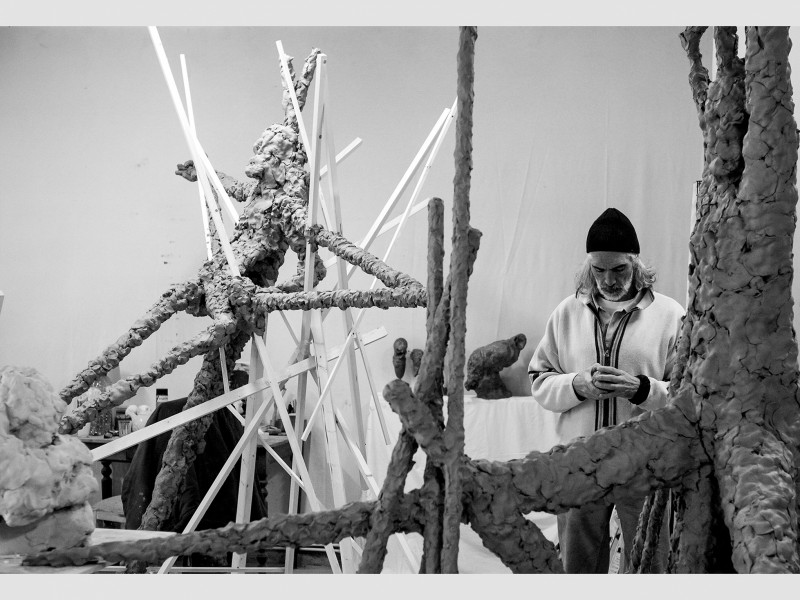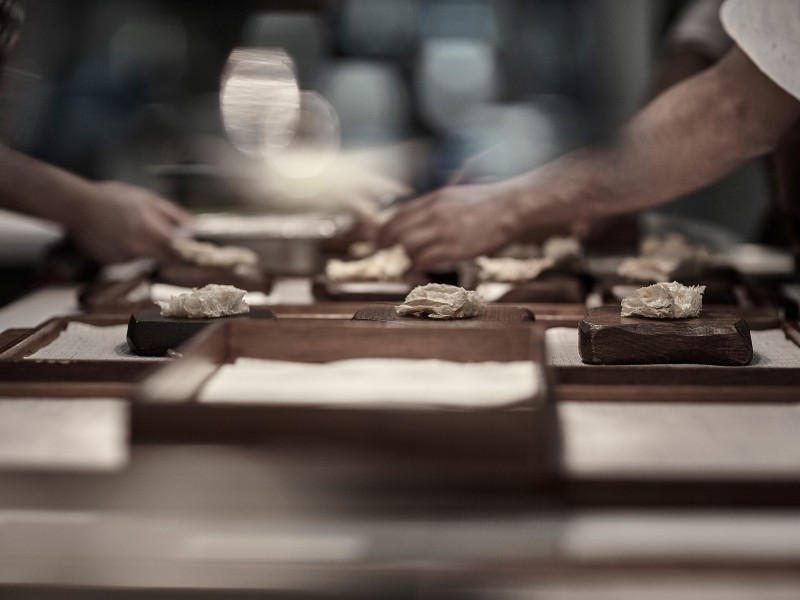Azuma Makoto is a renegade in the art of floral sculptures. In his haute couture Tokyo based floral shop, JARDINS des FLEURS, Azuma creates abstract forms and grand floral structures. His work has attracted coveted brands and individuals devoted to his artisanal skills. Azuma first established his flower business in 2002, and later founded an experimental laboratory Azuma Makoto Kaju Kenkyusho (AMKK) meaning Azuma Makoto Botanical Research Institute. Here he explores new and innovative representations of flowers and plants, mixing flora with juxtaposing contexts. Wrestless with the lack of space suitable for his experimentation and wanting to explore his own methods, Azuma opened gallery AMPG in 2007. Giving himself two years to focus on the project with an aim to produce one piece per month, AMPG was to become a major catalyst for his future sculptures. Neue Luxury took some time to uncover how he continues to reinvigorate and reinterpret the concept of flora in art and sculpture.
Roj Amedi: How do you draw inspiration from flowers? How do flowers communicate with you on both a sensorial and spiritual level?
Azuma Makoto: What I aspire to do is to capture and represent the ever changing beauty of flowers and plants from their birth to death. I believe I can receive inspiration from them by touching and feeling the subtle changes every day.
RA: Does your approach differ between your own private works, general commissions through JARDINS des FLEURS and your brand collaborations? How so?
AM: When I work on my private works, there is just me and flowers and no compromise. On the other hand, when I work with businesses and the like to create commercial art or collaborate with brands, I make a conscious effort to equally represent all the players involved: the client, flowers and me. When you manage to find a place where they can coexist in harmony, you can create something quite different from your private pieces, and I find that experience very inspirational and full of new discoveries. Commissions through the boutique are much smaller and more personal, but they still have the same elements of client, flowers and me. I try to represent the client’s message while keeping all elements in equilibrium.
RA: How has JARDINS des FLEURS evolved since its inception? Has your practice and methods changed significantly?
AM: I do not think JARDINS des FLEURS has changed in a major way since opening. It remains consistent with the original haute couture flower boutique concept. However, I am always looking for and experimenting with new techniques and methods. I have changed the kinds of flowers I use and also leaf works that surround them. As to the general taste, I tried arranging flowers more randomly than I had done before, in a way that is different from grouping (a method of placing flowers in groups of the same category). We are constantly attempting to break down, go beyond, and re-build our style to find new methods. I think this process is indispensable in order to keep offering fresh ideas to my clients.
RA: Your collaborations with the likes of Hermès, Dries Van Noten, Boucheron and Pierre Hermé have enabled a different manifestation of your work, whether through illustration, interior design, graphics or exhibitions and installations. How were you first approached to contribute to these projects? Were you already connected to these brands?
AM: It was different for each project. Hermès is one of my oldest clients and I have been providing flower arrangements for their Ginza Maison and many boutiques across Japan for many years. As for Dries Van Noten, Dries personally contacted me and asked for my contribution to the project. In every case, I decided to collaborate with these brands based on whether I deeply agreed with and respected the brands’ values, what they expressed and their spirituality.
RA: What are the values and spirituality that you best connect to and look for in your partnerships?
AM: I try to understand whether they have passion and respect for craftsmanship, and whether they are earnestly searching for ways to share their vision with their customers. I look for partners with spirituality, who seek to make an impact or provide hospitality to people, and who want to create an emotional connection instead of mere mass production.
RA: What was the idea behind establishing and opening gallery AMPG?
AM: I came up with the idea when I was looking for locations to experiment with and exhibit my work. During that period there weren’t many spaces like that in Japan, so I decided that I should create one myself. I wanted it to be a space where we could deal with the changing state of flowers on our own from blooming to death. Also, I wanted to do it properly, if I was going to do it at all. That is why I set a timeframe of two years.
RA: How did you sustain the commitment to produce a piece every month during the two-year life span of AMPG?
AM: It was not easy, but luckily I was always surrounded by plants and flowers and was interacting with them 365 days a year. They inspired so many ideas. I was always trying to figure how best to represent and express the flora, and then how to incorporate them into larger works. I learned so much in those two years by experimenting with various plants, and it certainly broadened my thinking and perspectives as an artist.
RA: What was the biggest lesson for you and your studio during this two-year period?
AM: The experience from this period broadened my perspectives and provided the inspiration for future projects. In that sense, it was a great opportunity for me to rediscover and cement my particular style. I’m never satisfied and constantly repeat the process of completing pieces, breaking them down, thinking, and then trying new physical manifestations of an idea. Some of the things I tried at AMPG did not work well, and some of the ideas guided me through later projects. I think I was chasing after the sensation of producing better work by constantly challenging myself.
RA: Your work involves botanical installations that typically take flora out of a natural context and often juxtaposes it with materials such as metal, glass and ice—in a way disrupting the connection to land and soil. What is your overall intent here?
AM: Plants are beautiful and complete as they are in their natural surroundings, so if we are going to alter them, it has to be done in a way that creates a different kind of beauty. That is why I visually disconnect them from the soil by exposing their roots or combining them with prosthetic materials. My intention is to create a sharp contrast between natural beauty and artificial beauty, which actually gives flora an opportunity to shine through in a unique way. My work is not an attempt to give them something or extend their lives, but to present them in a way that highlights every moment of their natural life cycles from various perspectives, and to bring out their beauty.
RA: Are all flowers created equal or do they live within a hierarchy?
AM: I think it depends on which aspect you are looking at. I would like to believe that just like human lives, all the flowers that are born to this world are equal and have the same value, no matter how small they are.
RA: What flowers are you using for your instalments? And how do you decide on what flowers to use?
AM: It really depends on each project. For Exobiotanica, I created a bouquet with flowers from all over the world and sent it up to space. For the Philippines project, we used a broad selection of local heliconia. I choose the main varieties and their composition depending on the concept and method I am using.
RA: Could you take us through one of your most recent trips to the Amazon? Have you been able to connect with local people and specialists? Or do you immerse yourself on your own?
AM: We planned the project in the Amazon ourselves. A friend of mine who lives in Manaus helped coordinate the trip. It was of course a completely unknown world to me, but fortunately I met this local botanist, who had lived in the Amazonian forest their entire life, who agreed to be my guide. The forest was fierce and brimming with life. It makes you feel like you would be eaten alive if you stopped moving. Whilst there I worked with plants that were indigenous to the area, created pieces and then took photographs. It was a very surreal experience. I felt as if I was arranging flowers in a vase called the Earth. It is not easy to do projects like this while running a flower boutique, but we would like to stay true to our own style and methods that no one else shares.
RA: What projects are on the horizon?
AM: I have been traveling around the world on a project called In Bloom since last year. The basic idea is to place flower arrangements in places where no plant or flower can exist. For the first instalment, we went to the Black Rock Desert in Nevada, USA and sent up some plants into space (stratosphere). Then we went to the Philippines to create an enormous floating sculpture made of flowers off the shores of the Negros Island. I intend to continue working on this project. There are already some new installments in progress all over the world such as Dallas, New York, and we even have one planned in France. I love seeing plants from all over the world with my eyes and touching them with my hands. It gives me so much inspiration and I would like to express it in a new form that is different from their natural state, to incite a new perspective and value.
Related Features
-
74
-
-
-

